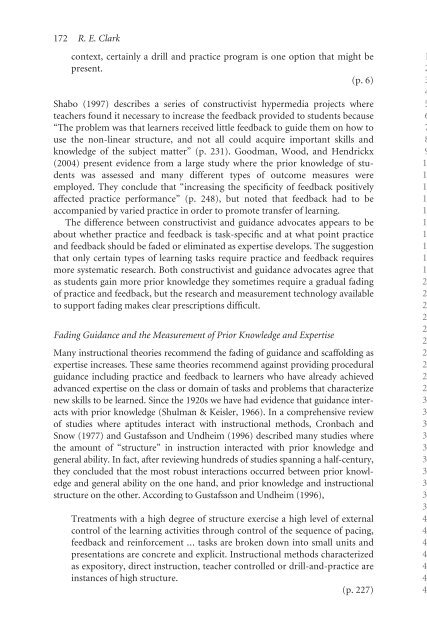9 How Much and What Type of Guidance is Optimal for Learning ...
9 How Much and What Type of Guidance is Optimal for Learning ...
9 How Much and What Type of Guidance is Optimal for Learning ...
Create successful ePaper yourself
Turn your PDF publications into a flip-book with our unique Google optimized e-Paper software.
172 R. E. Clarkcontext, certainly a drill <strong>and</strong> practice program <strong>is</strong> one option that might bepresent.(p. 6)Shabo (1997) describes a series <strong>of</strong> constructiv<strong>is</strong>t hypermedia projects whereteachers found it necessary to increase the feedback provided to students because“The problem was that learners received little feedback to guide them on how touse the non- linear structure, <strong>and</strong> not all could acquire important skills <strong>and</strong>knowledge <strong>of</strong> the subject matter” (p. 231). Goodman, Wood, <strong>and</strong> Hendrickx(2004) present evidence from a large study where the prior knowledge <strong>of</strong> studentswas assessed <strong>and</strong> many different types <strong>of</strong> outcome measures wereemployed. They conclude that “increasing the specificity <strong>of</strong> feedback positivelyaffected practice per<strong>for</strong>mance” (p. 248), but noted that feedback had to beaccompanied by varied practice in order to promote transfer <strong>of</strong> learning.The difference between constructiv<strong>is</strong>t <strong>and</strong> guidance advocates appears to beabout whether practice <strong>and</strong> feedback <strong>is</strong> task- specific <strong>and</strong> at what point practice<strong>and</strong> feedback should be faded or eliminated as expert<strong>is</strong>e develops. The suggestionthat only certain types <strong>of</strong> learning tasks require practice <strong>and</strong> feedback requiresmore systematic research. Both constructiv<strong>is</strong>t <strong>and</strong> guidance advocates agree thatas students gain more prior knowledge they sometimes require a gradual fading<strong>of</strong> practice <strong>and</strong> feedback, but the research <strong>and</strong> measurement technology availableto support fading makes clear prescriptions difficult.Fading <strong>Guidance</strong> <strong>and</strong> the Measurement <strong>of</strong> Prior Knowledge <strong>and</strong> Expert<strong>is</strong>eMany instructional theories recommend the fading <strong>of</strong> guidance <strong>and</strong> scaffolding asexpert<strong>is</strong>e increases. These same theories recommend against providing proceduralguidance including practice <strong>and</strong> feedback to learners who have already achievedadvanced expert<strong>is</strong>e on the class or domain <strong>of</strong> tasks <strong>and</strong> problems that characterizenew skills to be learned. Since the 1920s we have had evidence that guidance interactswith prior knowledge (Shulman & Ke<strong>is</strong>ler, 1966). In a comprehensive review<strong>of</strong> studies where aptitudes interact with instructional methods, Cronbach <strong>and</strong>Snow (1977) <strong>and</strong> Gustafsson <strong>and</strong> Undheim (1996) described many studies wherethe amount <strong>of</strong> “structure” in instruction interacted with prior knowledge <strong>and</strong>general ability. In fact, after reviewing hundreds <strong>of</strong> studies spanning a half- century,they concluded that the most robust interactions occurred between prior knowledge<strong>and</strong> general ability on the one h<strong>and</strong>, <strong>and</strong> prior knowledge <strong>and</strong> instructionalstructure on the other. According to Gustafsson <strong>and</strong> Undheim (1996),Treatments with a high degree <strong>of</strong> structure exerc<strong>is</strong>e a high level <strong>of</strong> externalcontrol <strong>of</strong> the learning activities through control <strong>of</strong> the sequence <strong>of</strong> pacing,feedback <strong>and</strong> rein<strong>for</strong>cement . . . tasks are broken down into small units <strong>and</strong>presentations are concrete <strong>and</strong> explicit. Instructional methods characterizedas expository, direct instruction, teacher controlled or drill- <strong>and</strong>-practice areinstances <strong>of</strong> high structure.(p. 227)1234567891111111111222222222233333333334444444
















